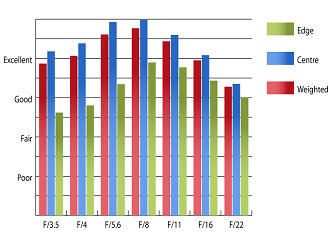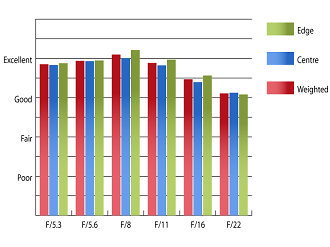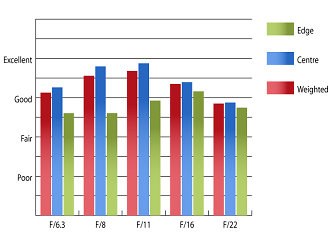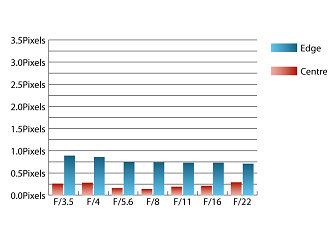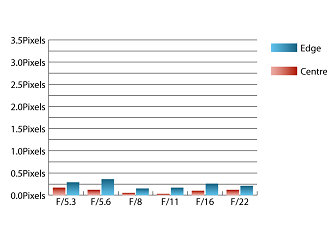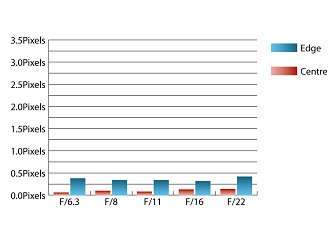Sigma 18-300mm f/3.5-6.3 Macro OS HSM C Lens Review
Sigma 18-300mm f/3.5-6.3 Macro OS HSM C Performance
At 18mm sharpness in the centre of the image area is excellent in the centre from maximum aperture, improving slightly as the lens is stopped down to between f/5.6 and f/8. Sharpness towards the edges is lack lustre by comparison at maximum aperture, although it improves to good levels as the aperture is stopped down to f/5.6 and beyond.
Zooming to 80mm results incredibly uniform sharpness across the frame. At maximum aperture clarity is a shade below excellent levels across the frame, increasing to excellent levels at f/8.
Finally, at 300mm although sharpness is reduced, the performance of this lens holds up quite well, given the huge zoom range. At maximum aperture sharpness is good in the centre and fairly good towards the edges. Stopping down to between f/8 and f/11 results in very good sharpness in the centre of the frame and good sharpness towards the edges.
How to read our charts
The blue column represents readings from the centre of the picture frame at the various apertures and the green is from the edges. Averaging them out gives the red weighted column.The scale on the left side is an indication of actual image resolution. The taller the column, the better the lens performance. Simple.
For this review, the lens was tested on a Nikon D300 using Imatest.
Chromatic aberrations are remarkably well controlled given the huge zoom range. Fringing is at its strongest at 18mm, but even then it does not exceed one pixel width. This low level of fringing should be difficult to spot, even in large prints, or harsh crops from the edges of the frame.
How to read our charts
Chromatic aberration is the lens' inability to focus on the sensor or film all colours of visible light at the same point. Severe chromatic aberration gives a noticeable fringing or a halo effect around sharp edges within the picture. It can be cured in software.Apochromatic lenses have special lens elements (aspheric, extra-low dispersion etc) to minimize the problem, hence they usually cost more.
For this review, the lens was tested on a Nikon D300 using Imatest.
Falloff of illumination towards the corners is typical of a lens of this type. At 18mm the corners are 1.91 stops darker than the image centre and at 300mm the corners are 1.48 stops darker. Visually uniform illumination is achieved with the lens stopped down by just over a stop from maximum aperture throughout the zoom range.
Distortion is often a weakness of high ratio zooms like this. Imatest detected 4.16% barrel distortion at 18mm, which is quite strong, although many similar lenses have just as much distortion. Pincushion distortion of 0.656% is present at the telephoto end, which shouldn't pose too many issues for most. If you require completely straight lines the distortion pattern is uniform across the frame throughout the zoom range, which should make applying corrections in image editing software relatively easy to apply.
A petal-shaped hood is supplied as standard with the lens, which does a good job of protecting the lens from extraneous light that may cause unwanted flare and loss of contrast. During testing there were no issues with flare and contrast holds up well, even when shooting into the light.
Value For Money
This 18-300mm Sigma lens includes optical stabilisation and costs around £399, which is a reasonable price given the specification.
Canon’s 18-200mm f/3.5-5.6 is their closest equivalent. This lens may have a brighter maximum aperture at 200mm and supports full time manual focus override, but it costs the same and gives up 100mm at the telephoto end.
Nikon's 18-300mm f/3.5-5.6 VR lens is much more expensive at around £600 and sports similar features to this Sigma lens, with the addition of full time manual focus override.
Sony’s closest equivalent is their 18-250mm f/3.5-6.3 DT AF lens, which costs around £360. As the Sony version of this Sigma lens doesn’t include stabilisation, the main differences are the 50mm difference at the telephoto end and the lack of silent focusing on the Sony lens.
Add your message
Please login here or if you've not registered, you can register here. Registering is safe, quick and free.
photodo Stats
428 MTF tests
74 in-depth photodo reviews
100+ users join each day
Help the lens community by reviewing or rating a lens today via our lens search
Latest Lens Reviews
- Chinon 28mm f/2.8 Vintage Lens Review
- Canon EF 70-200mm f/4L IS II USM Lens Review
- Samyang AF 85mm f/1.4 EF Review
- Sigma 70mm f/2.8 DG Macro Art Review
- Samyang AF 24mm f/2.8 FE Review
- Meike 50mm f/1.7 Review
- Tamron 70-210mm f/4 Di VC USD Review
- Lensbaby Burnside 35mm f/2.8 Review
- Asahi Super Takumar 50mm f/1.4 Review
- Asahi Super-Multi-Coated Takumar 135mm f/3.5 Review
